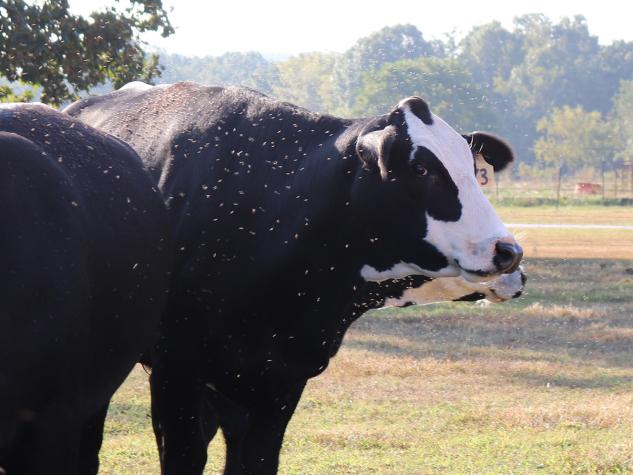WEST PLAINS, Mo. – An abundance of flies in cow herds is being reported to University of Missouri Extension specialists this summer, increasing the likelihood of cattle health issues, including pinkeye.
MU Extension livestock field specialist Elizabeth Picking estimates face flies are the biggest contributor this year to the spread of pinkeye in cattle.
“I’ve noticed that many producers don’t treat pinkeye until there is a big spot on the eye, rather than catching it early when their eyes are watering and they are blinking or squinting a lot,” Picking said.
Face flies are larger flies that feed on the secretions from eyes, nose and mouth. They’re very good at spreading pinkeye from animal to animal. The economic injury threshold is 10-15 flies per face, the lowest population density of a pest that will cause economic damage.
Clinically known as infectious bovine keratoconjunctivitis (IBK), pinkeye is a highly contagious bacterial infection in cattle. Pinkeye can cause weight loss, reduce milk production and decrease grazing efficiency. When both eyes are affected, cattle may die from starvation, thirst and accidents. Cattle with lightly pigmented skin around the eyes appear to be more susceptible. Consult your veterinarian about diagnosis, treatment and prevention of pinkeye, said MU Extension specialist in animal health and veterinary toxicology Tim Evans.
Prevention is key
• Mitigate factors contributing to ocular irritation, such as dust; mechanical trauma involving plant awns, tree limbs, facilities in disrepair, barbed wire and rough handling; and excessive sunlight, especially after the animal has developed pinkeye.
• Avoid very dusty bedding. Animals should be able find safe shelter from excessive sunlight and extreme weather.
• Clip pastures to remove seed awns and remove low-hanging branches looking for eyes to poke.
• Careful handling of livestock can minimize the risk of eye trauma and stress. Take special care to provide adequate restraint when working around an animal’s head.
• Avoid overcrowding.
• Good nutrition with adequate copper, selenium and vitamin A can also be helpful.
• Ideally, clean chutes with a disinfectant and remove manure.
Fly control strategies
Fly larvae mature in moist places like manure piles and winter-feeding areas. Dragging pastures and feeding areas to break up manure piles and wet feed or hay will dry out those fly larvae habitats. This practice can be used in conjunction with many different types of insecticide control such as:
• Fly tags. Fly tags can be effective on cows and weaned calves. If using fly tags, buy high-quality tags, put them in when fly numbers are relatively high, and remove them in the fall to reduce potential horn and face fly resistance. Using fly tags later in the season with dust baths or sprays earlier in the season can be very effective.
• Dust bags, oilers, back rubbers. Dust bags, oilers and back rubbers are most effective when cattle are forced to use them to get to mineral feeders or water sources. Free choice use of dust bags reduces the efficacy by 25%-50% compared to forced use. When using oil, don’t use motor oil, which can cause skin irritation. Quality mineral oil works better.
• Pour-ons and sprays. Pour-ons can provide a few weeks of protection from flies. If using sprays, complete coverage of the animal provides more control. Both pour-ons and sprays need to be reapplied frequently throughout the fly season.
• Feed-through products. Feed-through fly control products like oral larvicides and insect growth regulators prevent fly larvae from maturing in manure piles. Feed-through products need to be fed continuously, beginning before flies become a problem. Waiting until flies are heavy to begin a feed-through product is not ideal because the active ingredients take time to end up in the cow’s manure. It is suggested to start using a fly control mineral 30 days before the last frost in spring and ending after the first frost in the fall. The downside to using a fly control mineral is that fly populations may migrate from neighboring farms.
• Fly predators. Fly predators are small, non-stinging wasps that lay their eggs in the fly pupa (cocoon) and feed on fly larvae. These wasps do not bother livestock or people. To see a long-term reduction in flies, new predators need to be added to manure piles every month from April through September. As with the feed-through products, neighboring flies can migrate to your farm, so fly predators are most effective in conjunction with another control method.
Regardless of what application of fly control is used, alternating classes of insecticides from year to year will reduce insecticide resistance in flies for better control, said Picking.
“Using more than one fly control method with differing active ingredients can increase the control of fly numbers,” she said. “Remember to follow label directions for safe application and follow any withdrawal times listed.”
Vaccination
While there are vaccines to protect against pinkeye, the success rate varies.
There is a way to pinpoint vaccines to a particular herd, Picking added. “Several veterinarians in my area have started swabbing local herds to create their own autogenous vaccine for the area. I know quite a few producers that have gone to using the autogenous vaccines as well.”
The ideal time to vaccinate is before the detection of any clinical signs of pinkeye, according to Evans.
“Although most vaccines currently available ‘require’ a single injection, a report from Dr. John Angelos with the School of Veterinary Medicine at the University of California-Davis suggests that a booster three to four weeks after the first injection might help decrease the number of animals affected and, especially, would help lessen the severity of the clinical signs observed,” he said.
Treatment with patches on affected eyes can decrease healing times. Antibiotics can also be helpful in some circumstances; they should only be used after consulting with your veterinarian, said Evans.
Photo
Cows surrounded by flies
Cows surrounded by flies in Crane, Mo. Photo by Linda Geist.
Writer: Julie Harker
